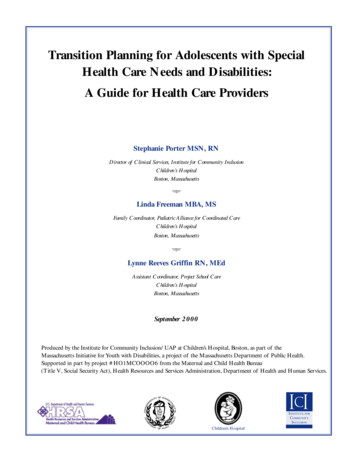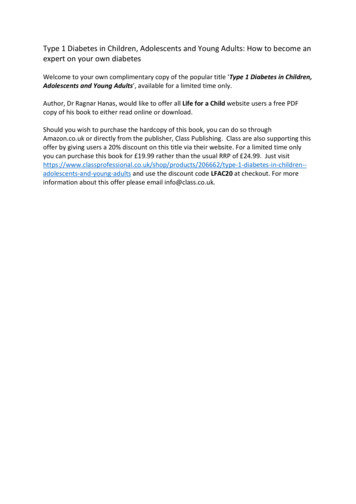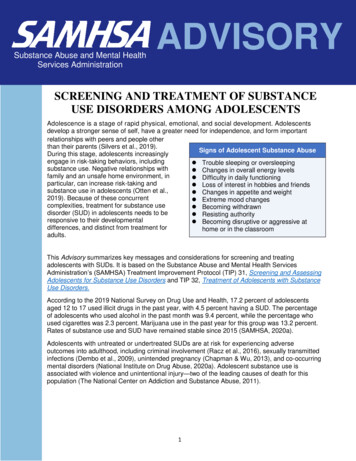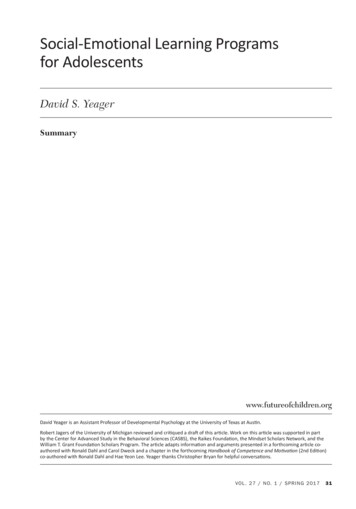
Transcription
Transition Planning for Adolescents with SpecialHealth Care Needs and Disabilities:A Guide for Health Care ProvidersStephanie Porter MSN, RNDirector of Clinical Services, Institute for Community InclusionChildren’s HospitalBoston, Massachusetts Linda Freeman MBA, MSFamily Coordinator, Pediatric Alliance for Coordinated CareChildren’s HospitalBoston, Massachusetts Lynne Reeves Griffin RN, MEdAssistant Coordinator, Project School CareChildren’s HospitalBoston, MassachusettsSeptember 2000Produced by the Institute for Community Inclusion/UAP at Children’s Hospital, Boston, as part of theMassachusetts Initiative for Youth with Disabilities, a project of the Massachusetts Department of Public Health.Supported in part by project #HO1MCOOOO6 from the Maternal and Child Health Bureau(Title V, Social Security Act), Health Resources and Services Administration, Department of Health and Human Services.ICIINSTITUTE FORCOMMUNITYINCLUSIONChildren’s HospitalA Guide for Health Care Providers 1
AcknowledgementsWe are most grateful to the Massachusetts Department of Public Health for their commitment to raisingawareness of the needs of children and adolescents with chronic illnesses and disabilities. We would especially liketo thank Deborah Allen and Nicole Roos for their guidance and direction. In addition, we want to thank thosewho generously contributed time to review this booklet or shared their expertise.Margaret Abisla MSN, CS, RNDeborah Allen ScDJulie Brown, StudentEmily Collins BSN, RNJames Cooley MDBarbara Donati, ParentS. Jean Emans MDSheila Fesko PhD, CRCCecilia Gandolfo MSEdMary Lou Gupta, ParentBrian Groden MDKathy Harney RN, MS, CPNPGail HavelickCarolyn Jacobs BAPeter Keenan MS, RNNadine Lada MEdJeffrey Lasker MD, FAAPEdward Lund, MDKathy Barrett Lewis, ParentTerri McLaughlin, ParentTinker Monroe, ParentSandra Morse, ParentJudith S. Palfrey MDKristin Porter, StudentPeter Rappo MD, FAAPKaren Regan MSN, RNNicole Roos MBACeci Shapland MSN, RNPolly Sherman, ParentLisa Sofis MPAJoanne Spencer, ParentLaurie Tautkas BACynthia Thomas MS, CRCSusan Tufts MAJoshua Sharfstein MDKaren Zimbrich MEd
ContentsHow This Booklet Can Help You . 9How To Use This Booklet . 10Introduction. 13What is Transition? . 14The Role of the Pediatrician . 14Issues for Health Care Providers . 15Provider Checklist and Timeline . 171. Transition: Health Care . 21Background . 21Understanding the Issues . 22Transition/Health Care Family Sheet . 23Taking Charge of Your Health Care: A Handout for Young Adults . 252. Transition: Education . 29Background . 29Understanding the Issues . 31Transition/Education Family Sheet . 33Taking Charge of Your Education: A Handout for Young Adults . 353. Transition: Employment . 39Background . 39Understanding the Issues . 41Transition/Employment Family Sheet . 43Taking Charge of Getting a Job: A Handout for Young Adults . 454. Transition: Recreation . 49Background . 49Understanding the Issues . 50Transition/Recreation Family Sheet . 51Taking Charge of Having Fun: A Handout for Young Adults. 53Additional Tools and Information for Families and Adolescents . 55Summary of Laws Related to Adolescent Transition . 75Glossary of Terms . 77
ForewordThis informative booklet should be on every pediatrician’s bookshelf.It is a compilation of facts that physicians who take care of childrenwith special health care needs should have. As children with specialhealth care needs grow into young adults we need to help them makethe transition to this next stage. Most of us are not completelyknowledgeable about the intricacies of this transition. This booklet laysit out in clear language that details what the parents need, the patientsneed, and the ongoing physician needs. Not only are there medical,social, educational, recreational, and employment issues, but there arelegal concerns to be considered. This booklet, in one place, details whatthe issues are and the state, federal and other resources available tohelp address each of them.Especially useful are the guides for the patient and guides for the familiesthat can be copied and handed out in the course of care. These checklistsremind everyone of those items requiring attention. It also hassuggestions of how they can be accomplished and many of the resourcesfor getting them done listed right on the same page.To my colleagues who receive this booklet, take a few minutes tofamiliarize yourself with its contents and read several of the sectionsbefore you put it on your bookshelf. Once you do that, you will take itoff that shelf often, as it will become a valuable tool in your care of ourvery special patients. This booklet is specific to Massachusetts but shouldbe replicated state-by-state because of its well-organized content.Eugenia Marcus, MD, FAAPPresident, Massachusetts ChapterAmerican Academy of Pediatrics
8 Transition Planning for Adolescents with Special Health Care Needs and Disabilities
How ThisBooklet CanHelp YouAs a Primary Care Provider, you support families in avariety of ways throughout the lives of their children.You are in a unique position to help and supportadolescents as they journey into adulthood, particularly childrenwith special health care needs and disabilities. Even as thenumber of young adults with special health care needs isincreasing, many families still experience this journey intoadulthood as lonely and challenging. To help you assist families,this booklet includes resources and strategies to guide yourinterventions with families and to focus their attention on fourkey facets of adulthood: health, education, employment andrecreation. This booklet may help to make these discussions aroutine part of your visits with adolescents with special healthcare needs and disabilities. Your role in incorporating and passingon information to adolescents in your practice is critical andwe hope this booklet will give you the tools you need to do so.A Guide for Health Care Providers 9
How To Use This BookletThis booklet is written for providers (pediatricians andnurses) but contains handouts that should be copied andgiven to families and adolescents.The booklet addresses four aspects of adulthood:1 HEALTH2 EDUCATION3 EMPLOYMENT4 RECREATIONEach of the four topic areas contain the following elements:Background Information and Issues:This introductory section is written for the provider andhighlights the important facts, concerns and challenges that definethe need for provider interventions.Family Fact Sheet:Each of these sheets should be copied and given to parents/guardians. The sheets provide important factual information,reminders, strategies and resources for families to consider as theyhelp their adolescents become adults.“Taking Charge” Sheet:These four teen-specific sheets can be copied and given toadolescents. The sheets promote self-care and advocacy, providetips and identify resources for additional information.10 Transition Planning for Adolescents with Special Health Care Needs and Disabilities
In addition, this booklet includes:Provider Checklist and Timeline:The provider checklist can be used as a tool to remind youto raise specific issues at different visits. We recommendcopying the checklist and putting one on the front of eachpatient’s chart for easy reference.Community Resources:Providers can help families by directing them to resources.Additional Tools and Information:The booklet contains other tools that will remind providersto initiate discussions on specific topics with families and/orprovide more detailed information where that might beneeded. This section also includes suggested readings forproviders and families.Summary of Important Laws:Laws that protect people with disabilities in the areas ofeducation, employment and recreation are briefly described.Glossary of Terms:Definitions of words used in the booklet.A Guide for Health Care Providers 11
12 Transition Planning for Adolescents with Special Health Care Needs and Disabilities
IntroductionIn recent decades the prognosis for children and youth withspecial health care needs and disabilities has changedsignificantly. Now more than 90% of children withdisabilities reach adulthood. In light of this, we face the newchallenge of providing appropriate services and resources toadolescents and young adults who deal with health issues.Underlying these changes in outcomes are changes in practice.New technologies and treatments have dramatically enhancedmedical capacity to care for children with special health careneeds and disabilities. Both medical advances and the trendtowards managed care have also shifted care out of the hospitaland into the community. This places new responsibility onprimary care pediatricians to be proactive in providing supportand information to adolescent clients with special health careneeds and disabilities. Chronic illness and disability impacts everyaspect of an adolescent’s life. Studies show that adolescents andadults with disabilities are at increased risk for substance abuse,sexual abuse, unemployment and limited social experiences. Theserisks can be reduced when adolescents are given support to liveactive, meaningful lives in their communities. Health careproviders play a critical role in helping the adolescent successfullyprepare for adulthood.A Guide for Health Care Providers 13
What is Transition?The Role of thePediatricianTransition is the term used to describe a dynamic process experienced byadolescents with special health care needs and disabilities as they becomeadults. Transition entails not only transfer of care to an adult provider butall facets of adult life, including health care, education, employment andrecreation. The goal of transition is for adolescents to move towardsautonomy.The 1990 passage of The Americans with Disabilities Act (ADA)affirmed the right of people with disabilities to participate in education,employment and recreation. Depending on a provider’s own experiencesand biases he/she will have his or her own expectations about theopportunities available to adolescents with special health care needs anddisabilities. Because the reality is that significant progress has been madein broadening opportunities for those with special health care needs anddisabilities, providers can benefit from being updated on what is available.Additionally providers may be unfamiliar with community services andresources that can help in the transition process. Becoming informedabout services and supports is critical. In order for the young adult toattain his/her potential, he/she needs a provider who can fosteropportunities in the areas of health, education, recreation andemployment.Moving the adolescent toward independence may be difficult for thefamily and the provider, yet it is an essential step in the process oftransition. The primary care provider is instrumental in facilitating thehealth care transition process. Assisting in the coordination ofcomprehensive care and empowering the adolescent to become asindependent as possible is the key to a smooth transition. It isappropriate for the primary care provider to be active in the transitionprocess for the following reasons.The primary care provider: Has a trusting relationship with the adolescent and his/her family; Is often a powerful influence on the adolescent and family; Can stimulate discussion about the adolescent’s future; Understands the nature and implications of the adolescent’s chronicillness or disability; Can help the family determine the appropriate time for transitiondiscussions based on the adolescent’s development and needs; Practices family-centered care.14 Transition Planning for Adolescents with Special Health Care Needs and Disabilities
Issues for HealthCare ProvidersIt is important to acknowledge that families and providers face manydifferent issues when moving through the transition process. It is helpfulto keep the following concepts in mind to ensure a positive transitionexperience. It is essential for the adolescent to be part of any team that makesdecisions about his/her future. Comprehensive transition planning should aim at continuous careof the young adult. Providers and families should use the model of “normalized” adulttransition as they chart a path for the adolescent with special healthcare needs and disabilities. It is safe to assume that typical lifeexperiences (in employment, recreation and education) have thesame importance and value for all adolescents. Transition, in all its forms, needs to be a shared responsibility of thepediatrician, the family and the adolescent. The pediatrician and the adult care provider need to develop acollaborative relationship. Adolescents and families need to be comfortable making a transitionto a new provider.Keeping these concepts firmly in mind can help the provider fulfill his/herrole as guide, support and facilitator in the transition process.Principles of Transition Services Transition is a process, not an event. The transition process should begin at the day of diagnosis. The adolescent and family should be involved in the decision process. Providers and parents should prepare to facilitate movement. Coordination of services and providers is essential.(White, 1997)A Guide for Health Care Providers 15
16 Transition Planning for Adolescents with Special Health Care Needs and Disabilities
Provider Transition Checklist and TimelineChecklist Instructions: The timeline provided here can be modified as developmentally appropriate for youradolescent patient. Use your clinical judgment as to which items apply to your patient. Refer to content-specificsections of this booklet for further information about these points.Ages11-13Ages14-16Ages17-19Ages20-22Meet privately with the adolescent for part of theoffice visit Encourage the adolescent to assume increasingresponsibility for his/her health care management Assure the adolescent understands his/her healthcondition and medications Send copies of reports, letters and tests to theadolescent and family Provide anticipatory guidance Nutrition and fitness Sexuality and relationships Substance abuse and smokingAssess the adolescent’s and the family’s readiness fortransfer to an adult health care provider Initiate discussion about transfer to an adult healthcare provider Identify possible adult care providers Encourage patient to meet and interview adultproviders Initiate communication with the adult providerthat the family has selectedImplement the transfer to an adult primary careprovider Transfer medical records Discuss nuances of care with the adult provider Follow-up after the transferAssess the adolescent's ability to make independentdecisions regarding health care, finances and otheradult concerns for determining whether there is aneed for guardianship/conservatorship Initiate referral for assessment of competence ifneeded Provide medical documentation Follow-up on the process with the familyName:HEALTH CAREProduced by the Institute for Community Inclusion at Children’s Hospital, Boston, as part of the Massachusetts Initiative for Youth withDisabilities, a project of the Massachusetts Department of Public Health. Supported in part by project #HO1MC00006 from the Maternal andChild Health Bureau (Title V, Social Security Act), Health Resources and Services Administration, Department of Health and Human Services.A Guide for Health Care Providers 17
Provider Transition Checklist and TimelineAges11-13Ages14-16Ages17-19Ages20-22 Make sure the adolescent and family know thatfederal law requires that transition planning begin atage 14, focusing on the student’s course of study as itrelates to the adolescent’s long-term plans Make sure the adolescent and family know thatstarting at age 16 needed transition services must beincluded in the student’s IEP. They should focus onthe goals, objectives, activities, and services related totransition. Remind the adolescent and family that the entitlementto special education services ends when the adolescentgraduates, withdraws from high school or reaches age22 Assess the adolescent's ability to make independentdecisions regarding education starting at age 18. Ifindependent decision-making does not seemappropriate, discuss the option of joint decisionmaking by the adolescent and the family. Remind the adolescent of his/her legal right to bepresent and participate in the educational planningmeetings required by special education lawAsk the adolescent and family how you can participatein the Individualized Education Program planningprocess. Advise families that at age 18 a student has the rightto make all decisions in relation to special educationprograms unless the family has petitioned the courtfor guardianship or the student has chosen to share ordelegate decision making to a parent.Remind the adolescent and family that if s/he is noteligible for special education services, s/he may still beeligible for 504 accommodationsDiscuss with the adolescent plans for furthereducation beyond high school Produced by the Institute for Community Inclusion at Children’s Hospital, Boston, as part of the Massachusetts Initiative for Youth withDisabilities, a project of the Massachusetts Department of Public Health. Supported in part by project #HO1MC00006 from the Maternal andChild Health Bureau (Title V, Social Security Act), Health Resources and Services Administration, Department of Health and Human Services.18 Transition Planning for Adolescents with Special Health Care Needs and DisabilitiesName:EDUCATION
Provider Transition Checklist and te discussion of different routes to employmentsuch as higher education, technical training orsupported employment Encourage the adolescent and family to explorecommunity vocational opportunities and to becomefamiliar with vocational services, even if furthereducation is planned. Advise families that at age 18 a student has the rightto make all decisions in relation to special educationprograms, including employment planning, unless thefamily has chosen otherwise or has petitioned thecourt for guardianship.Discuss with the adolescent and family theimportance of early work experiences and job-relatedskills such as resume preparation and interviewingRemind the adolescent and family that at age 14individualized transition planning should focus ondeveloping a vision for employment and education Encourage the adolescent and family to contact localand state agencies involved in employment services. Have the adolescent and family contact the SocialSecurity Administration to learn about and plan forfinancial aspects of employment, such as 9Ages20-22Discuss in-home and community recreation options Help families develop strategies to foster friendshipsand avoid social isolation Share health care information that may affect theadolescent’s ability to participate in recreationalactivities Name:EMPLOYMENTProduced by the Institute for Community Inclusion at Children’s Hospital, Boston, as part of the Massachusetts Initiative for Youth withDisabilities, a project of the Massachusetts Department of Public Health. Supported in part by project #HO1MC00006 from the Maternal andChild Health Bureau (Title V, Social Security Act), Health Resources and Services Administration, Department of Health and Human Services.A Guide for Health Care Providers 19
Young adults with special health careneeds and disabilities should transitionto an adult provider. What is my role asprimary care provider? Age 14 is an appropriate time tobegin the process of health caretransition planning andimplementation. The provider can reduce familystress and improve outcomes byproviding guidance and supportaround transition planning.20 Transition Planning for Adolescents with Special Health Care Needs and Disabilities
1BackgroundTTRANSITIONHEALTH CAREhere are two main components of health care transition for the adolescentwith special health care needs and disabilities:Increased self-management of health care on the part of the adolescent,andTransfer of care from pediatrician to adult care provider.Health care for the adolescent with special health care needs and disabilities ofteninvolves an intricate web of providers. The work of coordinating this networkfalls largely to families, but the primary care provider has a key role in assistingand supporting families. As an adolescent becomes older he/she needs to assumegreater responsibility for his/her health care management as individuallyappropriate. The primary care provider must help the adolescent, whose decisionmaking and problem-solving skills are still evolving, to take on this new role. Atthe same time, the primary care provider must encourage and work with thefamily to identify an appropriate adult health care team. Providers must investtime in transfer of information and coordination of care among multiplespecialists in the process of transitioning an adolescent to an adult provider.A Guide for Health Care Providers 21
Adolescents may experience fear, anxiety and a sense of loss when shifting to an adultprovider. Concerns may center around the need to introduce someone new to acomplex health history and a unique set of health care needs and challenges.Development of a new personal relationship may create anxiety. The family struggles to trust that their young adult can manage his/her own healthcare, with the parent in a less dominant role. If the adolescent has a special health care need or disability significant enough tointerfere with his/her ability to make important financial and medical decisions, theprovider will need to initiate referral for assessment of competence and assist withdocumenting the need for guardianship or conservatorship. This must be done beforethe adolescent reaches the age of 18. Families may also feel a sense of loss. Fear of the unknown when transitioning to anew provider is common. Providers with multidimensional relationships with the adolescent and family maythemselves feel sad at the prospect of transition.Understandingthe IssuesNext Steps1.Review the Transition Checklist and Timeline (pp. 17-19)2.We have included information sheets to share with families and the adolescentsyou treat. We recommend that you photocopy the following materials anddistribute them to the suggested audience.HandoutHealth Care Family Sheet (pp. 23-24)Taking Charge of your Health Care (pp. 25-26)Communicating with Doctors and Other HealthCare Providers (p. 57)Health Care Skills Checklist (pp. 58-59)Massachusetts State Resources (pp. 63-67)References and Suggested Readings (pp. 71-73)FamilyAdolescent For more information.Family TIESFamily TIES (Together In Enhancing Support)of Massachusetts is a statewide information andparent-to-parent support project for families ofchildren with special needs and chronic illness.Massachusetts Dept. of Public HealthSoutheast Regional Office109 Rhode Island RoadLakeville, MA 02347800-905-TIES (in-state)www.massfamilyties.org22 Transition Planning for Adolescents with Special Health Care Needs and DisabilitiesExceptional Parent 2000 Resource GuideAn annual resource guide providinginformation, support, ideas,encouragement and outreach for parentsand families of children with disabilitiesand the professionals who work withthem.555 Kinderkamack RoadOradell, NJ 07649-1517201-634-6550www.eparent.com
QTRANSITIONHEALTH CAREFamily SheetParents of children with special health care needs and disabilities need to plan,connect, advocate and find information on behalf of their child. Planning aheadis very important and makes a difference.This fact sheet on health care transition explains important issues and listspractical steps that should be addressed in adolescence.The fact sheet discussestwo aspects of health care transition. The first aspect is the need for increasedresponsibility by the adolescent for his/her own health care. The second is theneed for families to plan for transfer of care from the pediatric provider to theadult provider.Read the sheet and refer to it every now and then as you travel through thetransition process with your adolescent. Begin by age 14 but plan over a period of time. Make a plan that is specific to youradolescent and his/her special health care needs. If your adolescent has a special health care need or disability significant enough to interferewith his/her ability to make financial and medical decisions, you will need to file a petitionto the court six months before your adolescent turns 18 to maintain guardianship or toinitiate conservatorship. Ask the provider how and when age-appropriate information will be shared with youradolescent about: his/her disability or chronic illness, sexuality, preparing for parenthood,genetic counseling, vocational awareness, work opportunities and leisure time. Suggest to the provider that he/she meet privately with your adolescent to discuss topicssuch as physical, emotional and sexual development, relationships and friendships, sexuality,alcohol, drug and tobacco use, and family issues. Ask the provider who on his/her staff can assist you in care coordination. Ask the primary care provider or nurse for help in identifying others such as school nursesand personal care attendants who can help manage your adolescent’s care. Talk to your adolescent about his/her condition and/or disability in a way that he/she canunderstand. If your adolescent has developmental disabilities, work with his/her primarycare provider to choose the key points and figure out how to make them clear. Help your adolescent understand the importance of the medication he/she takes.A Guide for Health Care Providers 23
Encourage your adolescent to make his/her own health care appointments. Encourage your adolescent to prepare for doctor visits by writing down questions in advance. He/she should also keep his/her own health notes and records. Begin teaching your adolescent about his/her insurance coverage. Discuss with the primary care provider when you should consider transferring your adolescent’s careto an adult provider. If you decide that you should work towards a transfer of care, work with your adolescent’s primarycare provider to find appropriate adult providers. Talk to other families and young adults with similar special health care needs and disabilities to helpyou identify an appropriate adult health care provider for your adolescent. Schedule an interview visit with possible adult providers before transferring your adolescent’s care.If possible, encourage your adolescent to call and schedule the visit. Visit with each provider to determine if he/she is a good match for your adolescent. Ask your primary provider to transfer your adolescent’s medical records prior to transfer of healthcare to the adult provider.For more information.Family TIESFamily TIES (Together In Enhancing Support) of Massachusetts is a statewideinformation and parent-to-parent support project for families of children withspecial needs and chronic illness.Massachusetts Department of Public HealthSoutheast Regional Office109 Rhode Island RoadLakeville, MA 02347800-905-TIES (in-state)www.massfamilyties.orgExceptional Parent 2000 Annual Resource GuideA resource guide providing information, support, ideas, encouragement andoutreach for parents and families of children with disabilities and theprofessionals who work with them.555 Kinderkamack RoadOradell, NJ 07649-1517201-634-6550www.eparent.comProduced by the Institute for Community Inclusion at Children’s Hospital, Boston, as part of the Massachusetts Initiative f
Lynne Reeves Griffin RN, MEd Assistant Coordinator, Project School Care Children's Hospital Boston, Massachusetts September 2000 Produced by the Institute for Community Inclusion/UAP at Children's Hospital, Boston, as part of the Massachusetts Initiative for Youth with Disabilities, a project of the Massachusetts Department of Public Health.











